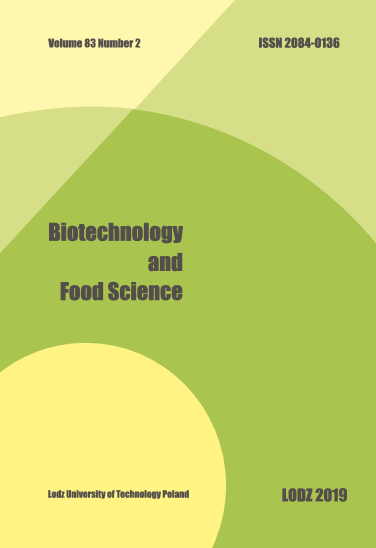Abstract
The aim of the work was to determine dietary fibre content (total, soluble and insoluble) in kale. Packages of the vegetable were bought in local stores in Lodz. Dietary fibre content determined during the research was compared with the information given by producers. C onducted research proved that kale is rich in dietary fibre ( from 4 .36 to 5.05 g per 100 g of product in fresh weight, mostly in form of insoluble dietary fibre). The results of determinations carried out in the laboratory co incide with the data declared by the producers.
References
Heimler D, Vignolini P, Dini MG, Vincieri FF, Romani A. An tiradical activity and polyphenol composition of local Brassicaceae edible varieties. Food Chem 2006, 99:464-469.
Sikora E, Bodziarczyk I. Composition and antioxidant activity of kale (Brassica oleracea L. var. acephala) raw and cooked. Acta Sci. Pol., Technol. Aliment. 2012,11(3):239-248.
Migliozzi M, Thavarajah D, Thavarajah P, Smith P. Lentil and Kale: Complementary Nutrient-Rich Whole Food Sources to Combat Micronutrient and Calorie Malnutrition. Nutrients 2015, 7(11):9285-9298.
Kunachowicz H, Nadolna I, Iwanow K. Przygoda B. Wartość odżywcza wybranych produktów spożywczych i typowych potraw, 2002, Wydawnictwo Lekarskie PZWL.
Thavarajah D, Thavarajah P, Abare A, Basnagala S, Lacher C, Smith P, Combs GF. Mineral micronutrient and prebiotic carbohydrate profiles of USA-grown kale (Brassica oleracea L. var. acephala). J. Food Compos. Anal. 2016, 52:9-15.
Lisiewska Z , Kmiecik W, Korus A. The aminoacid composition of kale (Brassica oleracea L. var. acephala), fresh and after culinary and technological processing. Food Chem 2008, 10:642-648.
Jones JM . CODEX-aligned dietary fiber definitions help to bridge the ‘fiber gap’. Nutr J. 2014, 13:34.
Gidley MJ, Yakubov GE. Functional categorisation of dietary fibre in foods: Beyond ‘soluble’ vs ‘insoluble’. Trends Food Sci. Tech. 2018.
McRae MP. The Benefits of Dietary Fiber Intake on Reducing the Risk of Cancer: An Umbrella Review of Meta-analyses. J. Chiropr. Med. 2018, 17(2):90-96.
McRae MP. Dietary Fiber Is Beneficial for the Prevention of Cardiovascular Disease: An Umbrella Review of Meta-analyses. J. Chiropr. Med. 2017, 16(4):289-299.
McRae MP. Dietary Fiber Intake and Type 2 Diabetes Mellitus: An Umbrella Review of Meta-analyses. J. Chiropr. Med. 2018, 17(1):44-53.
Brownlee IA, Chater PI, Pearson JP, Wilcox M D, Dietary fibre and weight loss: Where are we now? Food Hydrocoll. 2017, 68:186-191.
Prosky L, Asp NG, Furda I, DeVries JW, Schweizer TF, Harland BF. Determination of total dietary fiber in foods and food products: Collaborative study. J. AOAC Int. 1985, 68(4):677-679.
Lee SC, Prosky L. In ternational survey on dietary fiber definition, analysis and reference materials. J.AOAC Int. 1995, (78)1:22-36.
Korus A. Effect of preliminary processing, method of drying and storage temperature on the level of antioxidants in kale (Brassica oleracea L. var. acephala) leaves. LWF – Food Sci. Technol. 2011, 44(8):1711-1716.
Borge GIA, Solhaug KA, Bengtsson GB. Effect of cold storage and harvest date on bioactive compounds in curly kale (Brassica oleracea L. var. acephala). Postharvest Biol. Technol. 2009, 51(1):36-42.
Cao G, Sofic E, Prior R L. Antioxidant capacity of tea and common vegetables. J. Agric. Food Chem. 1996, 44(11): 3426-3431.

